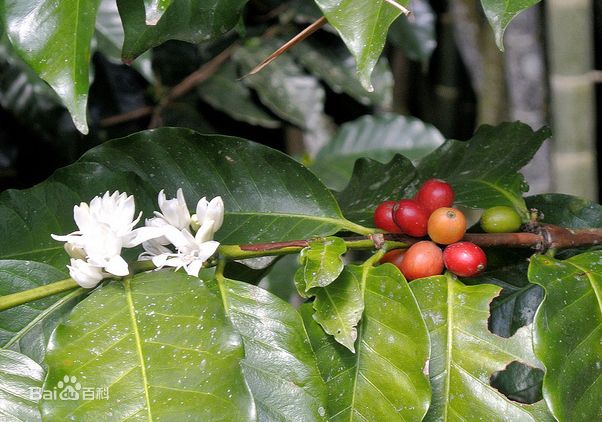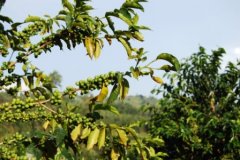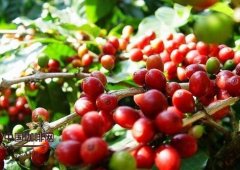Yirgacheffe African monosodium glutamate of kochere Manor in Yega Ficher, Ethiopia

Nowadays, there are more and more water washing treatment plants in Ethiopia. Small farmers sell the harvested coffee fruit to the processing plant, peel it and resell it in the auction system, and then transfer it to the port of Assab in Eritrea in the Red Sea and the port of Djibouti in Djibouti near the Bay of Aden. The coffee is the country's main agricultural export, but its own annual consumption is also astonishing, about 1500000bags/60kg. Accounted for 50% of the total generation. Wild coffee grows in the tropical rain forests of the southwestern plateau, and most of them are selected by hand, but because of this, many local people maliciously destroy the naturally formed rainforest areas-either felled or burned in order to reach the rugged mountains that are inaccessible. But it seriously affected the ecological balance.
Whether it is raw coffee washed or sunburned, all exported coffee is sent to the capital, Addis Ababa, and the DIRE DAWA auction exit in Hara province. The DIRE DAWA auction center usually exports sunburn halas in the area. Coffee information from different farms can be seen in the auction house every day to facilitate the purchase of traders. Several officials from Ethiopia also go in and out of the center every day to inspect and set grades. Each time a random sample of the same shipment of raw beans 3 kg inspection.
Yejaschuffe itself is a small town of about 20, 000 people, and the three neighboring producing areas, Wenago, Kochere and Gelena Abaya, are also classified as Yejasuffe because they produce coffee with almost the same flavor as Yejasuffe. Yejacheffe is similar to the neighboring Sidamo in terms of culture and geography, but it seems to be more favored to enjoy the advantageous conditions, top-quality Yega Chefe coffee with floral aromas, bright citrus acidity, lemon flavours and silky taste.
Kochere Cochel is located in southwestern Ethiopia, 25 miles north of the famous town of Yega Chefen. The production model is based on local small farmers sending production batches to cooperatives for unified processing. The local Chalalacktu village has about 100000 people who depend on coffee for a living, and related production activities have become their main source of income. Due to the benefits brought by coffee production, the local standard of living is much better than that of many Ethiopian villages, with sound health facilities, colleges and universities, and so on. The advanced processing equipment makes the coffee in Kochere area always have a high level of performance in the field of washing treatment, with the clean and sweet complex flavors of molasses and citrus.
Important Notice :
前街咖啡 FrontStreet Coffee has moved to new addredd:
FrontStreet Coffee Address: 315,Donghua East Road,GuangZhou
Tel:020 38364473
- Prev

Sidamo sidamo Coffee Shakiso shakisso producing area Ethiopia Sidamo Coffee Light
Nowadays, there are more and more water washing treatment plants in Ethiopia. Small farmers sell the harvested coffee fruit to the processing plant, peel it and resell it in the auction system, and then transfer it to the port of Assab in Eritrea in the Red Sea and the port of Djibouti in Djibouti near the Bay of Aden. The coffee is the country's main agricultural export, but its own annual consumption is also staggering.
- Next

Yega Xuefei Ethiopia Erega arichaG1 Grade Yega Chefe single Black Coffee
Nowadays, there are more and more water washing treatment plants in Ethiopia. Small farmers sell the harvested coffee fruit to the processing plant, peel it and resell it in the auction system, and then transfer it to the port of Assab in Eritrea in the Red Sea and the port of Djibouti in Djibouti near the Bay of Aden. The coffee is the country's main agricultural export, but its own annual consumption is also staggering.
Related
- What documents do you need to go through to open a coffee shop? coffee shop coffee shop certificate processing process
- How to purchase Coffee beans in small Cafe how to choose a suitable supplier for domestic Coffee supply Company
- How to drink Starbucks Fragrance White Coffee? how to make Australian White Coffee? what Italian coffee beans are recommended?
- The Story of Flora Coffee: the name of Flora Coffee Bean and the implication of the Flowers on Florna Coffee
- How much does a cup of coffee cost? How much is the profit of a cup of coffee? What is the profit of the coffee shop in a year?
- Yunnan small Coffee, known as "fragrant Coffee", introduces the characteristics of Alpine Arabica Coffee producing areas in Yunnan, China
- 2023 latest Starbucks full menu price list how much is a cup of Starbucks coffee what is better to drink the most popular hot and cold drinks recommended
- Starbucks different kinds of Coffee Price list Starbucks menu 2023 Top Ten Best drinks in Starbucks
- Starbucks Spring praise Comprehensive matching Coffee Bean theme Story Packaging implication and taste description
- The cost of a cup of coffee latte American coffee cost price and selling price

